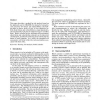Free Online Productivity Tools
i2Speak
i2Symbol
i2OCR
iTex2Img
iWeb2Print
iWeb2Shot
i2Type
iPdf2Split
iPdf2Merge
i2Bopomofo
i2Arabic
i2Style
i2Image
i2PDF
iLatex2Rtf
Sci2ools
CORR
2006
Springer
2006
Springer
Belief Calculus
This paper describes a method for risk analysis based on the approach used in CRAMM, but instead of using discrete measures for threats and vulnerabilities and lookup tables to derive levels of risk, it uses subjective beliefs about threats and vulnerabilities as input parameters, and uses the belief calculus of subjective logic to combine them. Belief calculus has the advantage that uncertainty about threat and vulnerability estimates can be taken into consideration, and thereby reflecting more realistically the nature of such estimates. As a result, the computed risk assessments will better reflect the real uncertainties associated with those risks.
Related Content
| Added | 11 Dec 2010 |
| Updated | 11 Dec 2010 |
| Type | Journal |
| Year | 2006 |
| Where | CORR |
| Authors | Audun Jøsang |
Comments (0)

